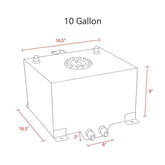Few modifications have the same influence on your car's engine performance as downpipe exhaust when it comes to getting the most out of it. To get a larger, less restrictive pipe, they replace the factory downpipe. Power and performance will increase noticeably as a result of the improved exhaust gas flow. Your car's exhaust sound can be made louder and sportier using downpipe exhausts. Naturally aspirated engines can also be used with the downpipe exhausts.
What is a Downpipe?
The exhaust gasses from the turbine housing of your car are directed into your exhaust system by a downpipe. The turbine housing is directly bolted to the downpipe. In order to move the exhaust gases through the system as efficiently as possible, it is essential. There is usually one or more restrictive catalytic converters in a downpipe.
Titanium or stainless steel are common materials for downpipe exhaust because they are strong and long-lasting. Because the exhaust system is exposed to heat and corrosive substances, they are also resistant to corrosion.
Pros
- Reduced exhaust back pressure
- Deeper, sportier sound
- Increased torque
- Quicker turbo reaction
- Extended turbo lifespan
- More horsepower with chip tuning
- Better fuel efficiency
Cons
Installing a downpipe exhaust in your truck has certain potential drawbacks, just like any modifications. Here are a few of the more noteworthy drawbacks:
- Voided warranty.
- elevated emissions.
- High Price.
- Perhaps prohibited in certain states.
Types of Downpipe Exhausts
Catted and catless downpipe exhausts are the two primary varieties.
The difference between a cat and a catless downpipe is also crucial information for drivers wishing to upgrade their downpipe. Cat downpipes have catalytic converters, whereas catless downpipes have not. This is a fairly basic difference. In order to make the gases in the exhaust system safer to release into the environment, catalytic converters change them. Therefore, since there isn't much conversion of exhaust pollutants, a catless downpipe will smell. Stated differently, they are not being sanitized. The majority of people select the catted downpipe because of this and the fact that it is environmentally friendly.
Catted Downpipe Exhausts
With catalytic converters, downpipe exhausts are catted. The usage of a catalytic converter lowers emissions. While they cost more than catless downpipe exhausts, catted downpipe exhausts are better for the environment.
Catless Downpipe Exhausts
A catalytic converter is absent from downpipe exhausts that are catless. In comparison to catted downpipe exhausts, catless downpipe exhausts generate more power but also more pollutants. Certain states prohibit the use of catless downpipe exhausts.
Depending on your needs and tastes, a downpipe exhaust system may be the ideal choice for you. Opt for a catted downpipe exhaust if pollution is a worry. The best choice for optimum power is a catless downpipe exhaust. Selecting a catless downpipe requires careful consideration of the benefits to performance as well as any applicable regulations.
How to choose the right Downpipe Exhaust
Take into account the following aspects when choosing a downpipe exhaust:
- Compatibility: Select a downpipe exhaust that is compatible with the make and model of your car.
- Performance: The downpipe's diameter has an impact on performance. A bigger diameter will enable greater exhaust gas flow, which will boost torque and horsepower. Larger diameters, however, may also result in louder engine exhaust noises.
- Cost: The price of downpipe exhaust might vary depending on its quality and capacity. Pick the option most in line with your budget.
- Emissions Regulations: In certain places, emissions regulations prohibit the use of catless downpipe exhausts. Check your state's laws and restrictions prior to purchasing a downpipe exhaust.
How To Install A Downpipe Exhaust
Follow these instructions to install the downpipe exhaust:
Remove the Old Downpipe: Start by uncoupling and taking your car's old downpipe out. Unclosing it from the exhaust manifold and additional attachment points might be necessary.
Installing the New Downpipe: Align the downpipe with your exhaust system by properly positioning it. Tighten the fasteners that are required to hold it in place.
Connect the Exhaust System: Reattach the mid-pipe and muffler to the new downpipe in order to complete the exhaust system connection. Verify that all connections are safe and that there is appropriate alignment.
Reinstall the Exhaust Manifold: Put the exhaust manifold back in place if you removed it. Ensure that it is properly sealed to stop exhaust leakage.
Reattach the Downpipe Hangers: Use hangers or classes made specifically for your car to fasten the downpipe. It helps the exhaust system maintain and support its weight.
Drive your car after installation to make sure everything is operating as it should. Notice any unusual noise or climate.
The downpipe exhaust may be installed appropriately and made to work with your car's emissions system by a qualified mechanic. The make and model of your car must be compatible with the downpipe exhaust.









